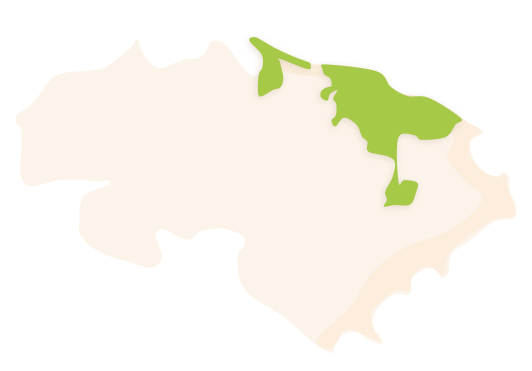Dénia is the capital of the current region of La Marina Alta and was the capital of the former marquisate demarcation. It is a town located a mere 14 metres above sea level, characterised by a large plain that stretches between two imposing Valencian natural parks, El Marjal and El Montgó (the latter with a peak located at 753 metres above sea level). It has a total municipal area of 66.18 km2, which is surpassed only by Xàbia and Benissa but has a much larger population than the rest of the towns in La Marina. There are 42,953 inhabitants, who are known as Deniers and Denieres.
 Dénia's municipal district. Surface area: 66.18 km². Population: 42,953. (INE data 2021).
Dénia's municipal district. Surface area: 66.18 km². Population: 42,953. (INE data 2021).HISTORY
Dénia, a seafaring city par excellence, has the longest coastline of La Marina, with beaches ranging from the fine sand of the area known as Les Marines to the round stones of L’Almadrava and the rocky parts of Les Rotes. The sea has marked the rhythm and growth of this small city since the Iberian era until today.
Various clues point to the existence of an Iberian settlement (Diniu) or a Greek one (Hemeroskopeion), but the Roman foundations of the city of Dénia are clear, with the name Dianium, as is demonstrated by numerous findings and documents. The writings of Strabo mention that in the 1st century BC Sertori’s troops established a naval base in Dianium. Later, due to the pacts between the Roman Empire and the Visigoths, Dianium became a bishopric under the authority of Toledo.
With the arrival of the Muslims and the establishment of the Xarq Al-Andalus region (the eastern part of Al-Andalus) in these lands, Daniya —the Arabic name of the city― reached incomparable levels of splendour, having a geographical extension that was practically equal to that of contemporary Dénia, with several neighbourhoods where shipyards or potteries were concentrated. These made up one of the most iconic images of Dénia, with the castle at the top, showing two fortified refuges (albacars) and the upper fortress (alcassaba). It became an independent taifa (a Muslim principality or kingdom of the Iberian Peninsula) under Alí Ibn Mujàhid in 1010, who annexed this territory with the Balearic Islands and turned the taifa of Daniya into a commercial maritime centre that even minted its own currency.
With the arrival and definitive Christian conquest made effective by Pere Eiximenis d'en Carròs in 1244, the city suffered a great regression, with the Christian population concentrated in homes built inside the first albacar. With the fifth Marquess of Dénia, from the house of Gómez de Sandoval y Rojas, Duke of Lerma, the city began to prosper again, and even Felipe III organised in Dénia special wedding celebrations with his wife, Margaret of Austria. In 1609, with the Moorish expulsion, Dénia became the port of departure for the outlawed population, directed towards the port of Oran in Northern Africa. Finally, in 1612, it obtained from King Felipe III the title of city, the only one in the entire region.
The other noteworthy period which helps to understand the physiognomy and history of the city of Dénia is the one related to raisin production. With the great rise in sales of this product, Dénia was the international port from which all the ships that exported the prized fruit departed, carrying the raisins to ports throughout the European and American continents. With this great economic boom, the city was modernised and quickly decorated with bourgeois buildings, casinos, theatres and other such leisure infrastructure. With the onslaught of the phylloxera crisis, the companies that manufactured boxes for packing raisins, as well as various other related artisans, were forced to turn their energies towards another noteworthy activity: the production of toys. The city's museums have been perfectly conceived to illustrate all these different moments, ranging from the Archaeological Museum located in the castle, to the Ethnological Museum and the Toy Museum. Nevertheless, the key role of the sea must not be forgotten, and neither should the fishing trade be overlooked, since it is one of the most important activities to bear in mind when trying to understand this city.
FESTIVITIES
- Les Falles are celebrated in Dénia from the 15th to the 19th of March.
- The main festivities (festa major) are celebrated from the 4th to the 12th of July, in honour of La Santíssima Sang.
- The festivities of Els Moros i Cristians are celebrated from the 13th to the 16th of August, in honour of Saint Roc.
- The festivities called El Porrat de Santa Llúcia and El Porrat de Santa Paula are celebrated on the 13th of December and the 26th of January, respectively.
- In addition, there are the various neighbourhood and street festivities, which are essential if you want to get to know the most authentic and less touristy aspects of Dénia.
GASTRONOMY
- The llandeta or cruet de peix dish and the arròs a banda dish are two classics of Dénia's seafood cuisine. Not to mention, of course, the famous red prawn.
- Rice with anchovies and spinach is a tasty but not extremely well-known rice dish. It also has variants with regards to the fish ingredient, since sardines or cod are used if there are no anchovies to be found.
- Dried octopus, which is air-dried in the sun, is another characteristic snack dish in Dénia, eaten as thin slices toasted on the grill and enjoyed with a bit of good olive oil on top.